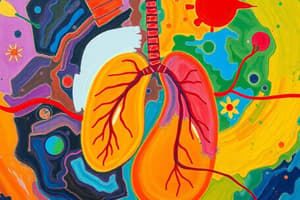Podcast
Questions and Answers
What are the reactants for Glycolysis?
What are the reactants for Glycolysis?
C6H12O6, 2NAD+, 2ADP+2P
What are the products for Glycolysis?
What are the products for Glycolysis?
2ATP (net gain), 2NADH, 2 Pyruvate
What are the reactants for Anaerobic Respiration?
What are the reactants for Anaerobic Respiration?
2 Pyruvate and NADH
What are the products of Anaerobic Respiration in humans?
What are the products of Anaerobic Respiration in humans?
What are the products of Anaerobic Respiration in yeast?
What are the products of Anaerobic Respiration in yeast?
What are reactants of Aerobic Respiration?
What are reactants of Aerobic Respiration?
What are the products of Aerobic Respiration?
What are the products of Aerobic Respiration?
What are the reactants of the Krebs Cycle?
What are the reactants of the Krebs Cycle?
What are the products of the Krebs Cycle?
What are the products of the Krebs Cycle?
What is the name of the Coenzyme that binds with Acetyl Acid?
What is the name of the Coenzyme that binds with Acetyl Acid?
What molecule is the final electron acceptor in the Electron Transport Chain?
What molecule is the final electron acceptor in the Electron Transport Chain?
Where does Glycolysis take place?
Where does Glycolysis take place?
Where does the Krebs Cycle take place?
Where does the Krebs Cycle take place?
Where does the Electron Transport Chain take place?
Where does the Electron Transport Chain take place?
How many ATP are generated from the E.T.C?
How many ATP are generated from the E.T.C?
How many times does the Krebs Cycle turn for one molecule of glucose?
How many times does the Krebs Cycle turn for one molecule of glucose?
What are NAD+ and FAD?
What are NAD+ and FAD?
What is the purpose of the Krebs Cycle?
What is the purpose of the Krebs Cycle?
How much ATP is produced from the Krebs Cycle?
How much ATP is produced from the Krebs Cycle?
Name the compound that enters the Krebs Cycle.
Name the compound that enters the Krebs Cycle.
Explain where the carbon dioxide comes from.
Explain where the carbon dioxide comes from.
What was the significance of Hans Krebs and Fritz Lipmann's findings?
What was the significance of Hans Krebs and Fritz Lipmann's findings?
How did Krebs contribute to the knowledge of Respiration?
How did Krebs contribute to the knowledge of Respiration?
How did Fritz Lipmann contribute?
How did Fritz Lipmann contribute?
What is a Coenzyme?
What is a Coenzyme?
Flashcards are hidden until you start studying
Study Notes
Glycolysis
- Reactants: C6H12O6 (glucose), 2 NAD+, 2 ADP + 2 P
- Products: 2 ATP (net gain), 2 NADH, 2 Pyruvate (Pyruvic Acid)
- Location: Cytoplasm
Anaerobic Respiration
- Reactants: 2 Pyruvate and NADH
- Products in humans: Lactic Acid and NAD+
- Products in yeast: Ethanol Alcohol and NAD+
Aerobic Respiration
- Reactants: C6H12O6 (glucose) and Oxygen
- Products: CO2, H2O, and ATP
- Location of Krebs Cycle: Mitochondria
- Location of Electron Transport Chain: Inner Mitochondrial Matrix
Krebs Cycle
- Reactants: Acetyl Co.A, NAD+, FAD+, ADP + P
- Products: ATP, CO2, FADH2, NADH
- Each cycle turns twice per glucose molecule, producing two ATP
- Main purpose: Break down Pyruvic Acid, generating high energy compounds for the Electron Transport Chain
- Coenzyme involved: CoEnzyme A
Electron Transport Chain (E.T.C)
- Final electron acceptor: Oxygen
- ATP generation from E.T.C: 36 ATP
Coenzymes
- NAD+ and FAD: Coenzymes that transport high energy electrons and hydrogen atoms to the E.T.C
- Definition: Coenzymes activate enzymes associated with vitamins
Historical Significance
- Contributions of Hans Krebs and Fritz Lipmann: Demonstrated respiration occurs in every cell and elucidated energy generation from glucose.
- Krebs' findings: Explained the series of reactions breaking down glucose into CO2.
- Lipmann's discovery: Identified CoEnzyme A, enhancing understanding of the Krebs Cycle.
Carbon Dioxide Production
- Source: Result from the breakdown of carbon molecules during cellular respiration.
Studying That Suits You
Use AI to generate personalized quizzes and flashcards to suit your learning preferences.




